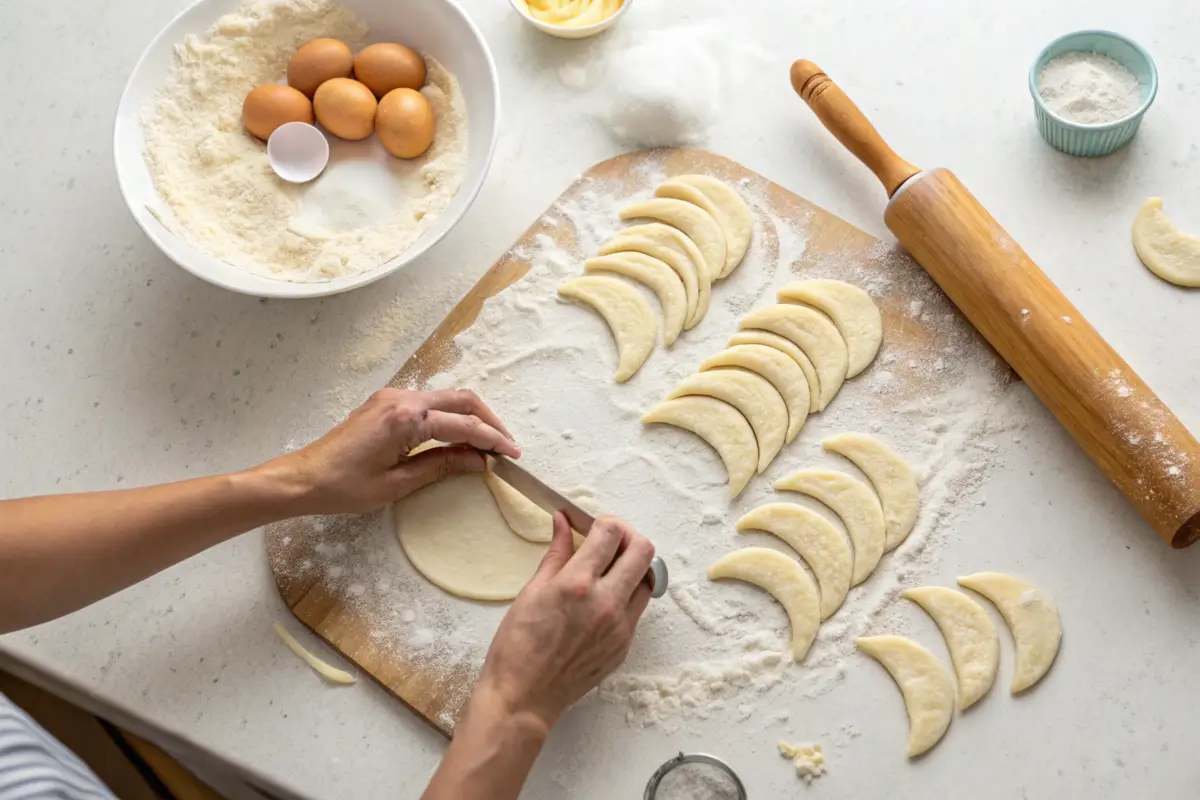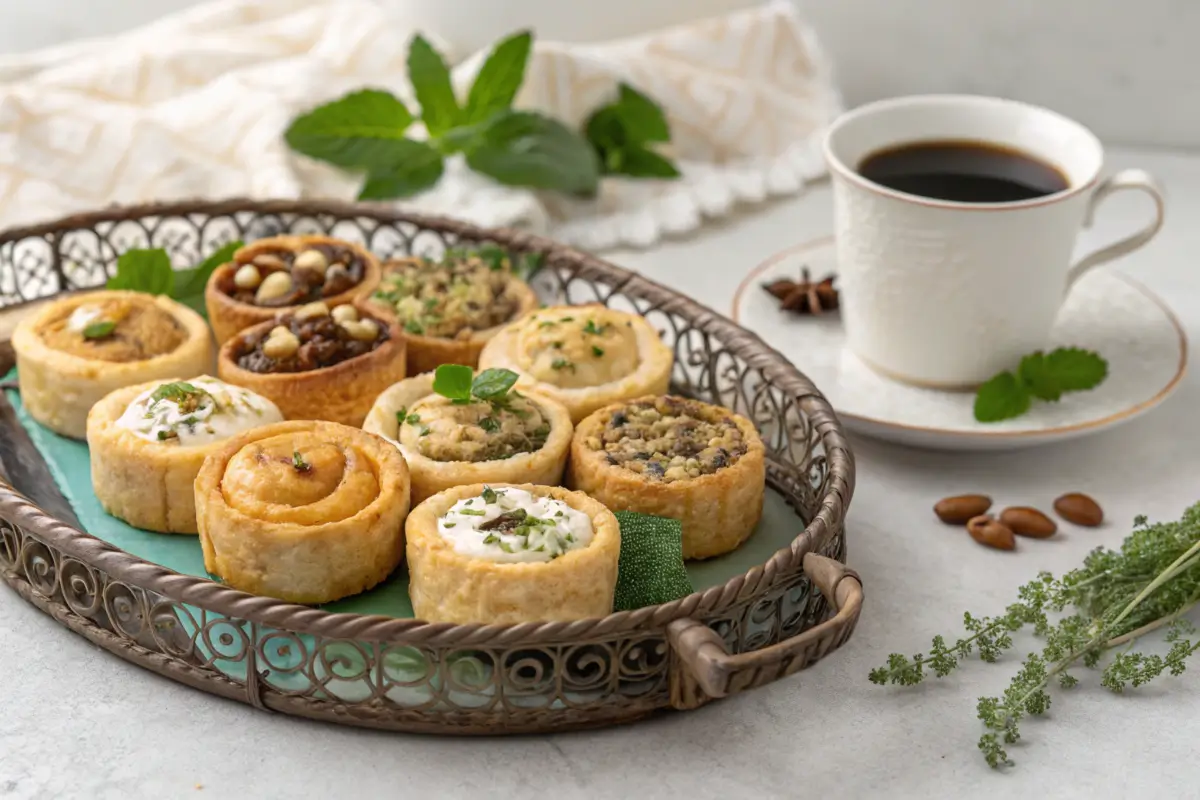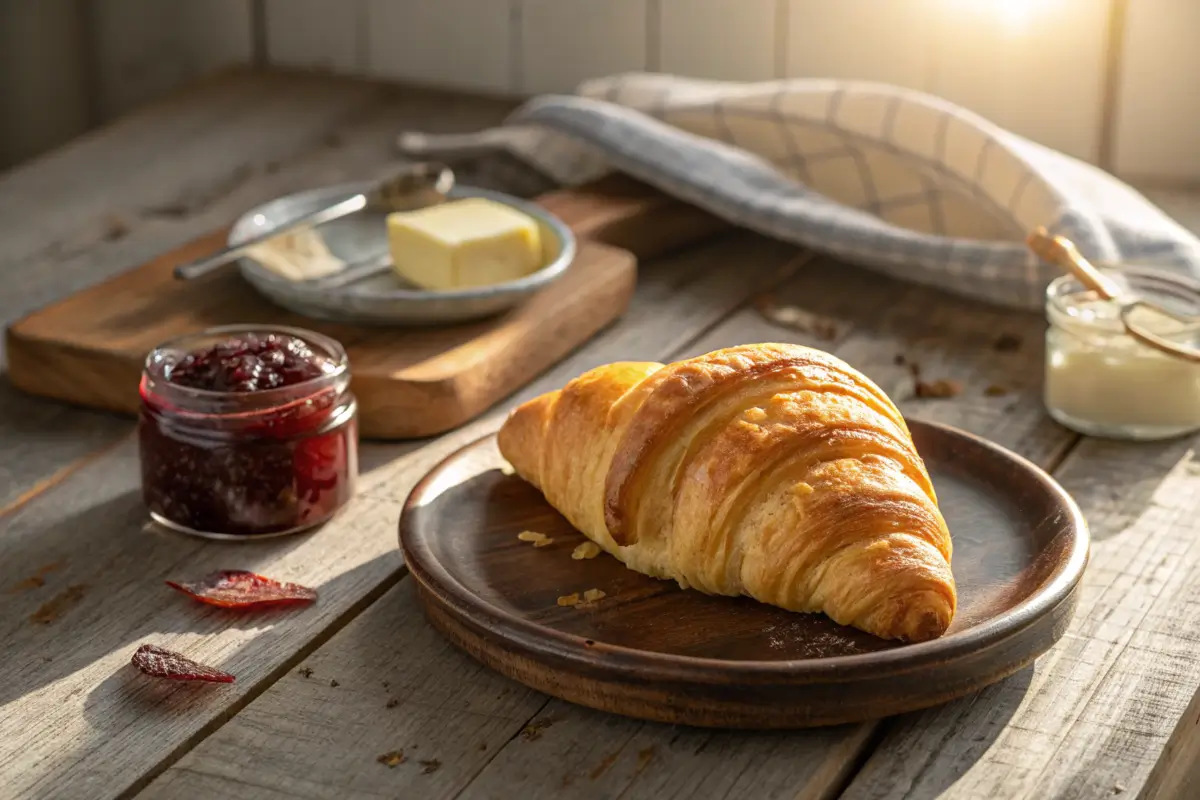Mastering a gipfeli recipe is your gateway to enjoying the irresistible charm of this classic Swiss pastry. Known for its crescent shape and flaky texture, gipfeli is a beloved treat, perfect for breakfast or a midday snack. In this guide, we’ll explore everything you need to create the perfect gipfeli recipe, from essential ingredients to troubleshooting tips and creative variations.
Introduction to Gipfeli Recipe
What is Gipfeli Recipe?
Gipfeli, often compared to the French croissant, is a staple in Swiss bakeries. These pastries boast a light, flaky texture that melts in your mouth. While they share a similar crescent shape, gipfeli typically have a firmer dough and a less buttery flavor profile than croissants. This makes them ideal for pairing with a variety of fillings, from sweet jams to savory spreads.
Origins of Gipfeli: A Swiss Tradition
The gipfeli recipe has deep roots in Swiss culinary traditions. Its name comes from the German word “Gipfel,” meaning “summit” or “peak,” symbolizing its crescent shape. Thought to be inspired by the Viennese kipferl, a predecessor to the croissant, gipfeli became a symbol of Swiss bakery culture, cherished at breakfast tables and cafes nationwide.
Gipfeli vs. Croissants: Key Differences
At first glance, gipfeli might look like croissants, but there are subtle differences. Unlike the ultra-buttery croissant, gipfeli use a more restrained amount of butter, making them slightly denser yet still flaky. They’re also less sweet, offering a neutral base for creative fillings. Additionally, while croissants are a global favorite, gipfeli remain uniquely Swiss, a testament to their cultural heritage.
Ingredients for the Perfect Gipfeli Recipe
Core Ingredients: Flour, Butter, and Yeast
The foundation of any gipfeli recipe lies in its ingredients, which are both simple and transformative. The primary components—flour, butter, and yeast—work in harmony to create the pastry’s distinct texture. Using high-quality all-purpose flour ensures a light yet firm structure, while cold butter is essential for the signature flakiness. Yeast, activated with warm milk or water, gives the dough its airy lift, making each bite a delight.
Optional Additions: Sweet or Savory Variations
What makes gipfeli so versatile is its adaptability. For a sweet version, you can add a touch of sugar or even a hint of vanilla extract to the dough. Fillings like chocolate, almond paste, or fruit preserves take the pastry to another level. On the other hand, savory options can include grated cheese, chopped herbs, or a sprinkling of sesame seeds. Don’t hesitate to experiment; the possibilities are endless.
Tips for Ingredient Selection
Choosing the right ingredients is crucial for achieving bakery-level results. Always opt for unsalted butter, as it gives you better control over the saltiness of your dough. When it comes to yeast, freshness is key—check expiration dates to ensure proper rising. For milk, full-fat varieties add richness and enhance the dough’s flavor. These small but significant choices can elevate your gipfeli recipe from good to exceptional.
Step-by-Step Recipe for Gipfeli
Preparing the Dough
To start, combine warm milk, yeast, and a pinch of sugar in a bowl, allowing the mixture to bloom for about 5 minutes. In a large mixing bowl, combine flour and salt, then gradually incorporate the yeast mixture. Add cubed cold butter and knead until the dough forms a cohesive ball. Chill the dough in the refrigerator for at least an hour to make it easier to handle.
Shaping the Pastries: Crescent Perfection
Once the dough has rested, roll it out on a floured surface into a rectangular sheet. Using a sharp knife or pizza cutter, divide the sheet into triangles. Starting from the wide base of each triangle, roll it towards the tip to create the classic crescent shape. Arrange the rolls on a lined baking sheet, ensuring enough space between them for rising.

Baking Tips for Flakiness and Golden Color
Preheat your oven to 375°F (190°C). Brush each pastry with an egg wash for a glossy finish. Bake for 12–15 minutes or until the gipfeli are golden brown and fragrant. For an even bake, rotate the tray halfway through. Let them cool slightly before serving; this ensures the layers are set and the pastry remains flaky.
Variations of Gipfeli Recipe
Mandelgipfeli: Almond-Filled Delight
One of the most beloved variations of the gipfeli recipe is the mandelgipfeli, or almond-filled pastry. This version features a rich almond paste or marzipan tucked into the crescent. The nutty filling complements the buttery dough, creating a pastry that’s perfect for those who crave something sweet yet sophisticated. To make this, simply add a dollop of almond paste before rolling the triangles into crescents. Sprinkle sliced almonds on top for a beautiful and crunchy finish.
Savory Options: Cheese and Herb Gipfeli
For a savory twist, try making cheese and herb gipfeli. These pastries are ideal as appetizers or snacks, and their versatility means you can customize the flavors to suit your preferences. Fill the dough with shredded cheese, such as Gruyère or Emmental, and a sprinkling of fresh or dried herbs like thyme or rosemary. Once baked, these savory crescents pair wonderfully with soups or salads.

Healthy Variations: Whole Wheat and Vegan Alternatives
Health-conscious bakers can enjoy gipfeli too! Swap out all-purpose flour for whole wheat to add fiber and a nutty flavor. To make vegan gipfeli, replace butter with plant-based margarine and use almond milk for the dough. Though these substitutions alter the texture slightly, they retain the pastry’s signature flakiness and are just as delicious.
Common Mistakes and Troubleshooting
Why Your Gipfeli Might Not Be Rising Properly
One common challenge when preparing a gipfeli recipe is dough that refuses to rise. This issue is usually linked to yeast, the magical ingredient responsible for airy, fluffy pastries. If the yeast is inactive or old, your dough won’t rise as it should. To avoid this, always check the expiration date on your yeast and activate it in warm liquid (around 110°F or 43°C). If the liquid is too hot, it can kill the yeast, rendering it useless.
Another frequent culprit is the temperature of your kitchen. Dough thrives in warm, draft-free environments. If your kitchen is too cold, consider placing the bowl of dough in a slightly warm oven (with the heat turned off) or near a sunny window. Lastly, insufficient kneading can prevent gluten development, leading to a dense texture. Be patient during kneading, as this step is crucial for creating the elasticity that allows the dough to rise properly.
Preventing Over-Baking or Under-Baking
When it comes to baking gipfeli, timing is everything. Over-baking can make the pastries dry and brittle, robbing them of their signature flaky texture. On the other hand, under-baking leaves the center doughy and unappetizing. To strike the perfect balance, follow your recipe’s recommended temperature and baking time closely.
An oven thermometer can be a lifesaver here, as many home ovens run slightly hotter or cooler than their settings suggest. Rotating your tray halfway through the bake ensures even browning, especially if your oven has hot spots. Keep a close eye on your gipfeli during the final minutes—they should emerge golden brown and fragrant, signaling they’re ready to enjoy.
Fixing Texture Issues: Flaky vs. Dense
The flaky texture of a perfect gipfeli is its hallmark, but achieving it requires care. If your pastries come out dense, the problem may lie in how the dough was handled. Overworking the dough can overdevelop the gluten, resulting in a tougher texture. Handle it gently, especially during rolling and shaping.
Another important factor is the chilling process. Chilling the dough between steps ensures that the butter layers remain intact, which is key to achieving the characteristic flaky layers. If the butter melts before baking, your gipfeli will lack the desired texture. Always keep the dough cold, and don’t skip the refrigeration steps.
Troubleshooting Specific Issues
Uneven Browning
If your gipfeli bake unevenly, it’s often due to inconsistent rolling or shaping. To fix this, roll the dough out evenly, and ensure all pastries are the same size. Additionally, place them on the tray with sufficient spacing to allow for even air circulation.
Burned Bottoms
Burned bottoms can ruin an otherwise perfect gipfeli. This often happens if the baking tray is too thin or the oven rack is too low. Using a quality, thick baking sheet and positioning it in the center of the oven can help. You can also use parchment paper or a silicone mat to prevent direct contact with the tray.
Dry Dough
If your dough feels dry and cracks during rolling, it may lack sufficient moisture. Adding a splash of milk or water while kneading can bring it back to life. Be careful not to overdo it—a little goes a long way.
Butter Leakage
Butter leaking from your gipfeli during baking is a common issue that can lead to less flaky results. This often occurs if the dough wasn’t chilled enough or was rolled too thin. Keeping the dough cold and handling it minimally ensures the butter stays locked in, creating the desired flaky layers.
Additional Tips for Perfect Gipfeli Recipe
Practice Patience
Making gipfeli can be a labor-intensive process, but patience truly pays off. From letting the dough rise properly to chilling it between steps, every pause is there to improve the final product. Rushing through these stages can compromise the texture and flavor.
Experiment with Fillings
If you’re troubleshooting basic dough issues, it’s a great time to experiment with fillings to keep the process fun. Sweet almond paste, Nutella, or savory cheese blends can make even imperfect gipfeli a joy to eat.
Use Quality Ingredients
From the butter to the flour, the quality of your ingredients matters. High-quality unsalted butter creates better layers, and fresh yeast ensures reliable rising. Small upgrades in ingredients can make a noticeable difference in your results.
Test One Batch at a Time
If you’re new to baking gipfeli, consider testing a small batch first. This allows you to identify any problem areas before committing to a larger batch. Once you’ve nailed your process, you can scale up with confidence.
Final Thoughts on Troubleshooting
Troubleshooting a gipfeli recipe might feel daunting at first, but each issue provides an opportunity to learn and improve. With a bit of patience and attention to detail, you can turn even a challenging baking session into a rewarding experience. Remember, baking is as much about enjoying the process as it is about the final product. Keep these tips handy, and you’ll be well on your way to mastering this delightful Swiss pastry.
FAQs About Gipfeli Recipe
What Makes Gipfeli Different from Croissants?
While both pastries share a crescent shape, gipfeli stand out due to their slightly denser and less buttery texture. The dough in a gipfeli recipe has a firmer structure, which makes it ideal for a variety of fillings, from sweet to savory. Croissants, by contrast, are known for their ultra-light and flaky texture, achieved through extensive laminating. This key difference gives each pastry its unique charm.
Can I Make Gipfeli Ahead of Time?
Absolutely! You can prepare gipfeli dough ahead of time and refrigerate it overnight. This not only saves time but also enhances the flavor as the dough develops a slight tang. Shaped but unbaked gipfeli can also be frozen for up to a month. Just thaw them in the refrigerator before baking, and they’ll come out fresh and flaky.
Are Gipfeli Always Sweet?
Not at all! One of the joys of gipfeli recipes is their versatility. While sweet versions filled with chocolate or almond paste are classic, savory options like cheese and herbs or even ham and spinach are equally popular. This flexibility makes them suitable for any occasion, from breakfast to snacks.
How Do I Store Gipfeli for Maximum Freshness?
To keep your gipfeli fresh, store them in an airtight container at room temperature for up to two days. For longer storage, freezing is your best bet. Wrap each pastry individually in plastic wrap, then place them in a freezer-safe bag. Reheat in the oven for a just-baked feel.
Nutritional Information for Gipfeli
Understanding the Nutritional Content of Gipfeli
For those curious about the health aspects of a gipfeli recipe, understanding its nutritional content is essential. While gipfeli are a delightful treat, they can also fit into a balanced diet when enjoyed in moderation. The buttery, flaky pastry provides energy, but the nutritional values may vary depending on ingredients and fillings.
Below is the approximate nutritional information for gipfeli (per 100g), based on a standard plain recipe:
| Nutrient | Amount (per 100g) |
|---|---|
| Calories | 350 kcal |
| Carbohydrates | 45g |
| Protein | 6g |
| Fat | 16g |
| Saturated Fat | 10g |
| Sugar | 5g |
| Fiber | 2g |
| Sodium | 300mg |
Key Takeaways
Gipfeli provide a rich source of energy, mainly from carbohydrates and fats. While they may not be the lightest snack, their indulgent flavor and satisfying texture make them worth every bite. To reduce calories, consider smaller portions or alternative ingredients, such as whole-grain flour or plant-based margarine. Always pair with a balanced diet to enjoy these pastries guilt-free!
Conclusion: Mastering the Art of Gipfeli
Summing Up Your Gipfeli Recipe Journey
Learning how to make gipfeli is a rewarding experience that brings the flavors of a Swiss bakery right into your home. From understanding its history and ingredients to perfecting your technique, each step enhances your baking skills and appreciation for this iconic pastry.
Encouragement to Experiment and Share
Don’t be afraid to experiment with fillings and flavors! Whether you stick with a traditional gipfeli recipe or explore creative variations, the possibilities are endless. Sharing your creations with friends and family will spread the joy these pastries bring. Remember, every bite is a testament to your effort and love for baking. So, roll up your sleeves, preheat your oven, and start creating your own delicious gipfeli today!

